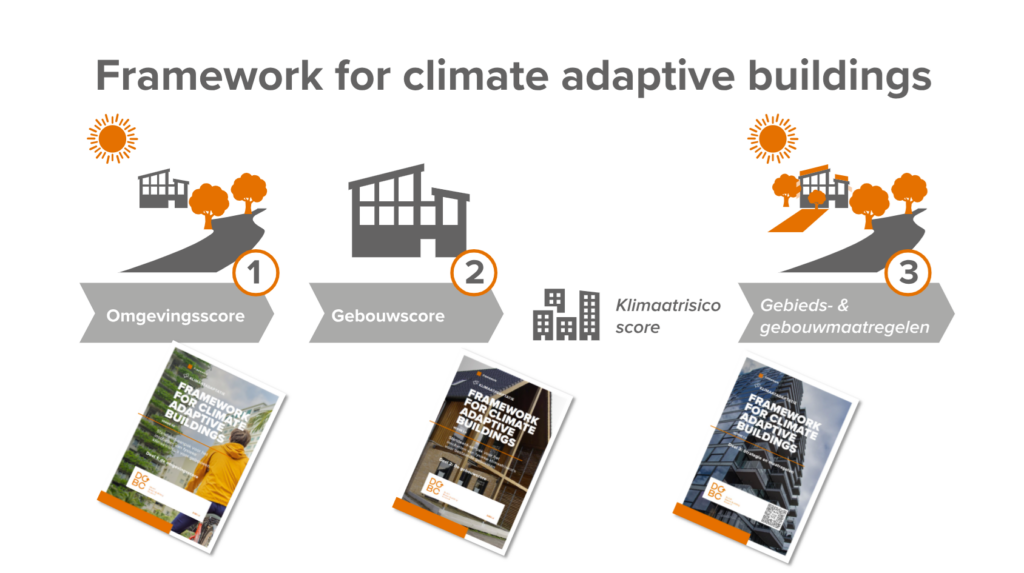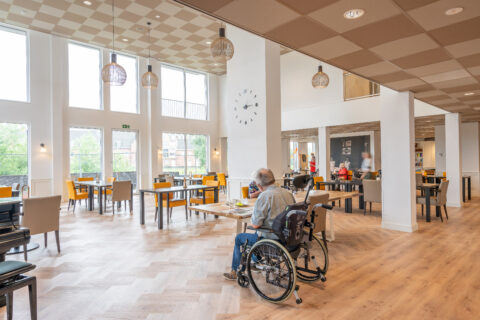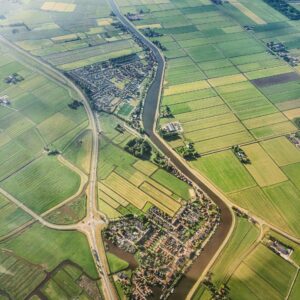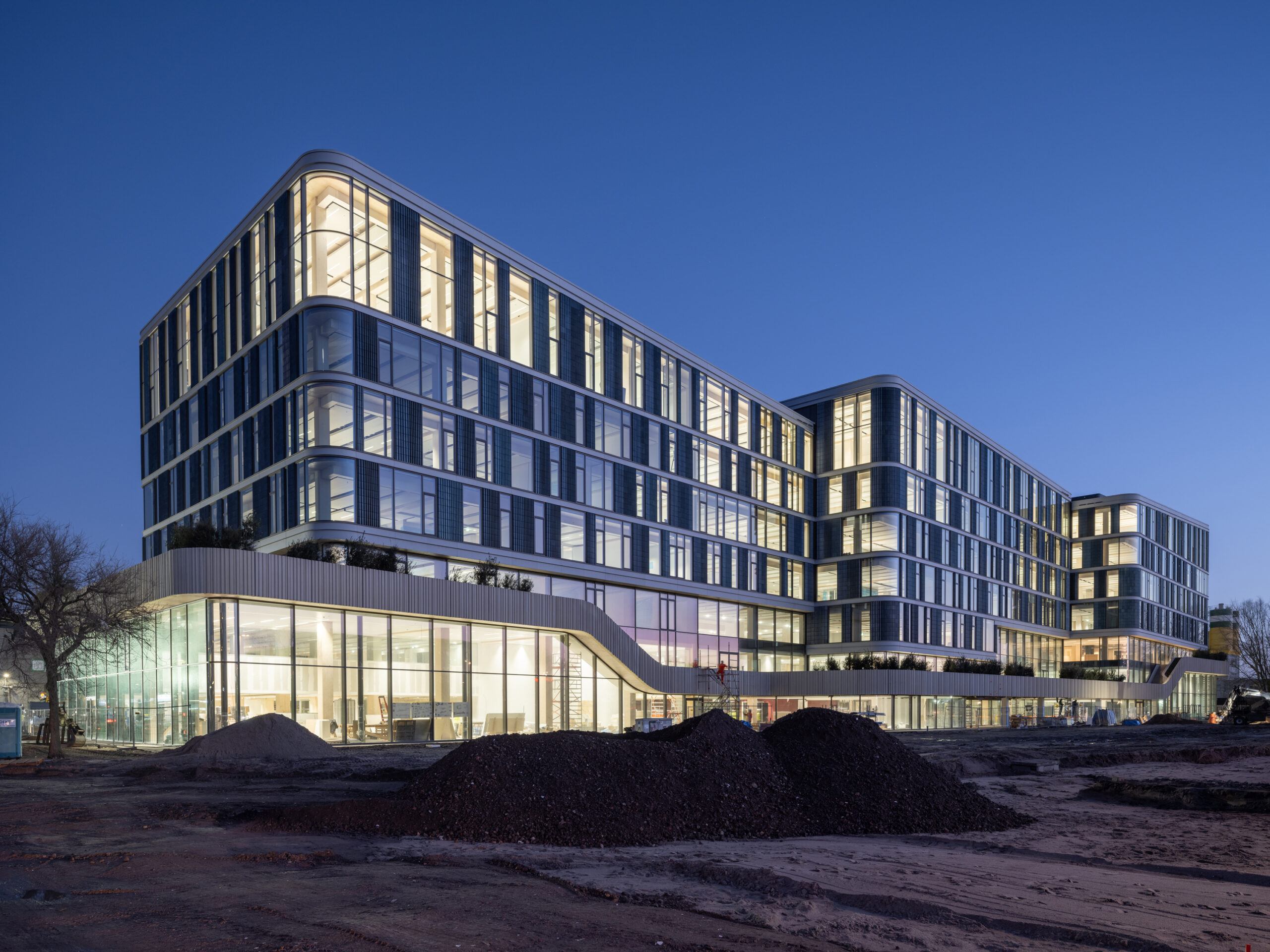


Hoe maak je de fysieke klimaatrisico’s op gebouwniveau inzichtelijk? Hoe groot is bij een specifiek gebouw de kans op hittestress, op verzakking bij droogte, op wateroverlast of zelfs overstroming? Lastige vragen die nogal eens verschillend worden beantwoord. Het analyseren van en rapporteren over klimaatrisico’s in vastgoedportfolio’s is steeds vaker gemeengoed, onder andere vanwege de Europese rapportageverplichtingen (zoals CSRD, SFDR en EU Taxonomie). Stilzitten is voor gebouweigenaren, woningcorporaties, beleggers en overheden geen optie meer. Handelen naar geconstateerde risico’s is urgent en noodzakelijk. Maar hoe constateer je die risico’s?
Een breed gedragen standaard methodiek daarvoor ontbrak. DGBC heeft daarom vanaf 2022 met een brede alliantie van financiële instellingen, kennisinstituten, adviseurs en overheden gewerkt aan een collectief ‘Framework for Climate Adaptive Buildings’ waarin transparant wordt beschreven hoe fysieke klimaatrisico’s op gebouwniveau kunnen worden vastgesteld.
De methodiek kijkt naar eerst naar de blootstelling (omgevingsscore op gebiedsniveau) en vervolgens naar de kwetsbaarheid van het gebouw (gebouwscore op basis van gebouwkenmerken). En kijkt daarna naar gebieds- & gebouwmaatregelen (de adaptatiestrategie). Oftewel:


Op basis van de omgevingsscore (deel 1) en gebouwscore (deel 2) samen kan vervolgens een klimaatrisicoscore voor het gebouw worden vastgesteld. Daarna gaat het om het definiëren van gebieds- & gebouwmaatregelen die kunnen helpen om de geconstateerde risico’s tegen te gaan of weg te nemen (deel 3).
Gebouweigenaren krijgen op deze manier een beeld van de kwetsbare gebouwen in hun portfolio. De methode plaatst rode vlaggen op dat deel van je gebouwenportfolio waar je beter naar moet kijken.
Ook voor woningcorporaties geeft de aanpak bruikbare inzichten over de aard en omvang van de klimaatrisico’s in de woningvoorraad. Er loopt op dit moment een trainingstraject speciaal voor woningcorporaties. Lees hier meer.
Het Framework for Climate Adaptive Buildings is mede mogelijk gemaakt door ruim 40 partijen, waaronder vastgoedbeleggers, financiële instellingen, kennisinstituten, adviseurs en overheden. Dit zijn: Ministerie van Binnenlandse Zaken en Koninkrijksrelaties, Ministerie van Infrastructuur en Waterstaat, Rijksdienst voor Ondernemend Nederland, Provincie Gelderland, Provincie Utrecht, Provincie Zuid-Holland, Metropoolregio Amsterdam, ING, Rabobank, ABN AMRO, Verbond van Verzekeraars, W/E, Bouwinvest, MN, a.s.r. real estate, CBRE IM, Vesteda, IVBN, Altera, NSI, Achmea Real Estate, BPD, Esri Nederland, Wereldhave, Sweco, Climate Adaptation Services, Nelen & Schuurmans, TAUW, Arcadis, HKV, Deltares, Nieman, Royal HaskoningDHV, Hogeschool van Amsterdam, Witteveen+Bos, &Flux, stichting RIONED, OSKA, Groene Huisvesters en Merosch.


Sommige vastgoedpartijen hebben de methodiek van het Framework inmiddels ingebed in hun eigen dashboards. Anderen vragen hulp van adviseurs bij het doorlichten van hun portfolio. Het Framework for Climate Adaptive Buildings is inmiddels door een grote groep adviesbureaus opgepikt en ‘ingebed’ in de tools en methodieken die zij aanbieden. De in bovenstaand tableau genoemde bureaus hebben meegedacht en meegewerkt bij de ontwikkeling van het Framework, waardoor zij goed kennis hebben van hoe het Framework werkt. Ook andere aanbieders/adviseurs hebben de methodiek opgenomen in hun propositie. Er is op dit moment geen controle op de juiste toepassing van het Framework door de verschillende partijen. De kwaliteitsborging rondom de toepassing van het Framework is wel een onderwerp van gesprek, zie beheer en onderhoud.
DGBC gaat in 2025 in gesprek met gebruikers van de methodiek om op te halen hoe de ervaringen zijn en waar verbetermogelijkheden liggen. Naast verbeteringen van de methodiek ligt er een belangrijke aanleiding voor actualisatie in de nieuwe klimaatscenario’s van IPCC en KNMI. Dit leidt tot nieuwe open data in de Klimaateffectatlas. Ook is er inmiddels meer informatie over de relatie tussen klimaatverandering en het verergeren van storm en hagel, waardoor dit thema wellicht ook moet worden benoemd in het Framework. Ook de behoefte aan meer kwaliteitsborging rondom de toepassing van het Framework zal onderwerp van gesprek zijn in de gebruikersgroepen.
Vragen of wil je meer informatie? Neemt contact op met Jan Kadijk.




In deze zipfile vind je alle drie de delen van het Framework: de Omgevingsscore (publicatie 11-2022), de Gebouwscore (publicatie 07-2023) en de Adaptatiestrategie (publicatie 06-2024). Ook vind je in dit pakket de Maatregelentabel als losse Excel.
"*" geeft vereiste velden aan






















Sinds zomer 2024 huist mediaconcern DPG Media in een nieuw pand: Mediavaert Amsterdam. Het gebouw dat werd ontwikkeld door Being, is een van de grootste hybride houten kantoorgebouwen van Europa. Het werd begin 2024 opgeleverd en biedt naast veel kantoorruimte ook een tweelaagse parkeergarage, diverse ruimtes voor bijeenkomsten, maar ook radiostudio’s, restaurants en sportfaciliteiten. Mediavaert […]
Bekijk dit project


